Torrential Flood Water Management: Rainwater Harvesting through Relation Based Dam Suitability Analysis and Quantification of Erosion Potential
Abstract
1. Introduction
2. Materials and Methods
2.1. Study Area
2.2. Geospatial Dataset
2.3. Indicator’s Relation and Suitability
- Normalized values of indicators
- Actual thematic layer values
- Inter weights between selected indicators
- Intra weights for each box unit
2.4. Quantitative Analysis
2.5. Sediment Analysis and Dam Life
2.5.1. Rainfall Erosivity (R) Factor
2.5.2. Soil Erodibility (K) Factor
2.5.3. Topographic LS Factor
2.5.4. Cover (C) and Control Practice (P) Factor
2.6. Sediment Yield (SY) and Sediment Delivery Ratio (SDR)
3. Results
3.1. Dam Suitability
3.2. EAC Curve
3.3. Soil Erosion (SE)
3.3.1. R-Factor
3.3.2. LS-Factor
3.3.3. K Factor
3.3.4. C Factor
3.4. Soil Erosion (SE)
3.5. Sediment Yield and Dam Life
4. Discussion
5. Conclusions
- RDSA technique classified total of 269 box-units in very high to very low classes for reservoir and dam wall suitability.
- Qualitative analysis using RDSA technique results in two suitable dam sites (Dam-A and Dam-B) for the management of flash flood water.
- Quantitative analysis reveals maximum possible capacity of 364 million m3 and 838 million m3 of Dam-A and Dam-B, respectively.
- Soil loss estimation using RUSLE method results in average annual SE of 75 t-ha−1y−1.
- At sub-catchment level LS, R, percentage of sand and silt concentrations show significant relation with SE.
- SDR and SE based annual average sediment of 298,073 tons and 318,000 tons will feed the Dam-A and Dam-B, respectively
- SY results substantiate approximate lives of 87 and 90 years for Dam-A and Dam-B at height of 150 ft and 200 ft, respectively.
Author Contributions
Funding
Institutional Review Board Statement
Data Availability Statement
Acknowledgments
Conflicts of Interest
References
- Gardiner, E.S.; Hodges, J.D.; Fristoe, T.C. Flood Plain Topography Affects Establishment Success of Direct-Seeded Bottomland Oaks. In Gen. Tech. Rep. SRS–71; US Department of Agriculture, Forest Service, Southern Research Station: Asheville, NC, USA, 2004; pp. 581–585. [Google Scholar]
- Gioti, E.; Riga, C.; Kalogeropoulos, K.; Chalkias, C. A GIS-based flash flood runoff model using high resolution DEM and meteorological data. Earsel Eproc. 2013, 1, 33–43. [Google Scholar] [CrossRef]
- Munir, B.A.; Ahmad, S.R.; Hafeez, S. Integrated hazard modeling for simulating torrential stream response to flash flood events. Isprs Int. J. Geo-Inf. 2019, 9, 1. [Google Scholar] [CrossRef]
- Munir, B.A.; Iqbal, J. Flash flood water management practices in Dera Ghazi Khan City (Pakistan): A remote sensing and GIS prospective. Nat. Hazards 2016, 81, 1303–1321. [Google Scholar] [CrossRef]
- Norbiato, D.; Borga, M.; Degli Esposti, S.; Gaume, E.; Anquetin, S. Flash flood warning based on rainfall thresholds and soil moisture conditions: An assessment for gauged and ungauged basins. J. Hydrol. 2008, 362, 274–290. [Google Scholar] [CrossRef]
- Gaume, E.; Bain, V.; Bernardara, P.; Newinger, O.; Barbuc, M.; Bateman, A.; Blaškovičová, L.; Blöschl, G.; Borga, M.; Dumitrescu, A.; et al. A compilation of data on European flash floods. J. Hydrol. 2009, 367, 70–78. [Google Scholar] [CrossRef]
- Liste, M.; Grifoll, M.; Monbaliu, J. River plume dispersion in response to flash flood events. Application to the Catalan shelf. Cont. Shelf Res. 2014, 87, 96–108. [Google Scholar] [CrossRef]
- Borga, M.; Boscolo, P.; Zanon, F.; Sangati, M. Hydrometeorological analysis of the 29 August 2003 flash flood in the eastern Italian Alps. J. Hydrometeorol. 2007, 8, 1049–1067. [Google Scholar] [CrossRef]
- Li, X.; Huang, S.; Sun, T.; Xin, J. Design and Implementation of Flood Monitoring and Assessment System. In Proceedings of the 2011 International Symposium on Image and Data Fusion (ISIDF), Tengchong, China, 9–11 August 2011; pp. 1–3. [Google Scholar]
- Munir, B.; Imran, H.; Hanif, M. Spatial hazard assessment practices in data poor areas: A participatory approach towards natural disaster management. Int. J. Sci. Basic Appl. Res. IJSBAR 2015, 22, 69–80. Available online: http://gssrr.org/index.php?journal=JournalOfBasicAndApplied&page=article&op=view&path%5B%5D=3799&path%5B%5D=2255 (accessed on 8 July 2020).
- Petrovic, A. Challenges of torrential flood risk management in Serbia. J. Geogr. Inst. Jovan CVIJIC SASA 2015, 65, 131–143. [Google Scholar] [CrossRef]
- Veldkamp, T.I.E.; Wada, Y.; Aerts, J.C.J.H.; Döll, P.; Gosling, S.N.; Liu, J.; Masaki, Y.; Oki, T.; Ostberg, S.; Pokhrel, Y.; et al. Water scarcity hotspots travel downstream due to human interventions in the 20th and 21st century. Nat. Commun. 2017, 8, 15697. [Google Scholar] [CrossRef]
- Li, Z.; Li, W.; Ge, W. Weight analysis of influencing factors of dam break risk consequences. Nat. Hazards Earth Syst. Sci. 2018, 18, 3355–3362. [Google Scholar] [CrossRef]
- Wu, M.; Ge, W.; Li, Z.; Wu, Z.; Zhang, H.; Li, J.; Pan, Y. Improved set pair analysis and its application to environmental impact evaluation of dam break. Water 2019, 11, 821. [Google Scholar] [CrossRef]
- Ge, W.; Li, Z.; Liang, R.Y.; Li, W.; Cai, Y. Methodology for establishing risk criteria for dams in developing countries, case study of china. Water Resour. Manag. 2017, 31, 4063–4074. [Google Scholar] [CrossRef]
- Jozaghi, A.; Alizadeh, B.; Hatami, M.; Flood, I.; Khorrami, M.; Khodaei, N.; Ghasemi Tousi, E. A Comparative Study of the AHP and TOPSIS Techniques for Dam Site Selection Using GIS: A Case Study of Sistan and Baluchestan Province, Iran. Geosciences 2018, 8, 494. [Google Scholar] [CrossRef]
- Kumar, M.G.; Agarwal, A.K.; Bali, R. Delineation of potential sites for water harvesting structures using remote sensing and GIS. J. Indian Soc. Remote Sens. 2008, 36, 323–334. [Google Scholar] [CrossRef]
- Al-Ruzouq, R.; Shanableh, A.; Yilmaz, A.G.; Idris, A.E.; Mukherjee, S.; Khalil, M.A.; Gibril, M.B.A. Dam site suitability mapping and analysis using an integrated GIS and machine learning approach. Water 2019, 11, 1880. [Google Scholar] [CrossRef]
- Sayl, K.N.; Muhammad, N.S. Estimation the physical variables of rainwater harvesting system using integrated GIS-based remote sensing approach. Water Resour. Manag. 2016, 30, 3299–3313. [Google Scholar] [CrossRef]
- Pandey, A.; Chowdary, V.M.; Mal, B.C.; Dabral, P.P. Remote sensing and GIS for identification of suitabl e sites for soil and water conservation structures. Land Degrad. Dev. 2011, 22, 359–372. [Google Scholar] [CrossRef]
- Syst, E.; Attribution, C.C.; Weerasinghe, H. Water harvest-and storage-location assessment model using GIS and remote sensing. Hydrol. Earth Syst. Sci. Discuss. 2011, 8, 3353–3381. [Google Scholar]
- Shit, P.K. Gully Erosion Studies from India and Surrounding Regions; Springer Nature: Berlin/Heidelberg, Germany, 2019. [Google Scholar]
- Vaezi, A.R. Assessment of soil particle erodibility and sediment trapping using check dams in small semi-arid catchments. Catena 2017, 157, 227–240. [Google Scholar] [CrossRef]
- Chuenchum, P.; Xu, M.; Tang, W. Estimation of Soil Erosion and Sediment Yield in the Lancang–Mekong River Using the Modified Revised Universal Soil Loss Equation and GIS Techniques. Water 2020, 12, 135. [Google Scholar] [CrossRef]
- Walling, D.E. Human impact on the sediment loads of Asian rivers. Sediment Problems and Sediment Management in Asian River Basins. IAHS Publ. 2011, 349, 37–51. [Google Scholar]
- Ashraf, A. Modeling risk of soil erosion in high and medium rainfall zones of Pothwar region, Pakistan. Proc. Pak. Acad. Sci. Pak. Acad. Sci. B Life Environ. Sci. 2017, 54, 67–77. [Google Scholar]
- Walling, D.E. Measuring sediment yield from river basins. In Soil Erosion Research Methods; Routledge: London, UK, 2017; pp. 39–82. [Google Scholar]
- Gelagay, H.S.; Minale, A.S. Soil loss estimation using GIS and Remote sensing techniques: A case of Koga watershed, Northwestern Ethiopia. Int. Soil Water Conserv. Res. 2016, 4, 126–136. [Google Scholar] [CrossRef]
- Atoma, H.; Suryabhagavan, K.; Balakrishnan, M. Soil erosion assessment using RUSLE model and GIS in Huluka watershed, Central Ethiopia. Sustain. Water Resour. Manag. 2020, 6, 12. [Google Scholar]
- Ullah, S. Geospatial assessment of soil erosion intensity and sediment yield: A case study of Potohar Region, Pakistan. Environ. Earth Sci. 2018, 77, 705. [Google Scholar] [CrossRef]
- Stephens, T. Manual on Small Earth Dams: A Guide to Siting, Design and Construction (No. 64); Food and Agriculture Organization of the United Nations (FAO): Rome, Italy, 2010. [Google Scholar]
- Rangsiwanichpong, P.; Kazama, S.; Gunawardhana, L. Assessment of sediment yield in Thailand using revised universal soil loss equation and geographic information system techniques. River Res. Appl. 2018, 34, 1113–1122. [Google Scholar] [CrossRef]
- Maqsoom, A.; Aslam, B.; Hassan, U.; Kazmi, Z.A.; Sodangi, M.; Tufail, R.F.; Farooq, D. Geospatial assessment of soil erosion intensity and sediment yield using the Revised Universal Soil Loss Equation (RUSLE) model. ISPRS Int. J. Geo-Inf. 2020, 9, 356. [Google Scholar] [CrossRef]
- Javed, M.Y.; Nadeem, M.; Javed, F. Technical Assistance Consultant’s Report Pakistan: Additional Works for the Preparation of Hill Torrent Management Plan (Financed by TASF) Revised Design/Feasbility Report. 2007. Available online: https://www.adb.org/sites/default/files/project-document/65489/39590-pak-tacr.pdf (accessed on 1 July 2020).
- Gallant, J.C.; Dowling, T.I. A multiresolution index of valley bottom flatness for mapping depositional areas. Water Resour. Res. 2003, 39, 1347–1359. [Google Scholar] [CrossRef]
- Riley, S.J.; De Gloria, S.D.; Elliot, R. A Terrain Ruggedness that Quantifies Topographic Heterogeneity. Intermt. J. Sci. 1999, 5, 23–27. [Google Scholar]
- Conrad, O.; Bechtel, B.; Dietrich, H.; Fischer, E.K.; Gerlitz, L.; Wehberg, J.; Wichmann, V.; Böhner, J. System for Automated Geoscientific Analyses (SAGA) v. 2.1. 4. Geosci. Model Dev. Discuss. 2015, 8, 1991–2007. [Google Scholar] [CrossRef]
- Khanna, P.N. Indian Practical Civil Engineer’s Handbook, 8th ed.; P.N. Khanna for Engineer’s Publishers: New Delhi, India, 1993. [Google Scholar]
- Gavade, V.V.; Patil, D.R.R. Site Suitability Analysis for Surface Rainwater Harvesting of Madha Tahsil, Solapur, Maharashtra: A Geoinformatic Approach. 12th ESRI India User. 2011, pp. 1–7. Available online: http://esriindia.com/Events/UC2011_files/WR_UCP0018.pdf (accessed on 10 October 2019).
- Adhikary, R.G.C.E.; Rai, S.; Shrestha, A. Resource Manual on Flash Flood Risk Management, 3rd ed.; Perlis, A., Ed.; International Center for Integrated Mountain Development: Khatmando, Nepal, 2012; Available online: http://agris.fao.org/agris (accessed on 25 August 2020).
- FAO. Simple Methods for Aquaculture. 2014. Available online: ftp://ftp.fao.org/FI/CDrom/FAO_Training/FAO_Training/General/x6705e/Index.htm (accessed on 18 February 2020).
- Ekenberg, L.; Hansson, K.; Danielson, M.; Cars, G. Deliberation Representation Equity: Research Approaches, Tools and Algorithms for Participatory Processes; Open Book Publishers: Cambridge, UK, 2017. [Google Scholar] [CrossRef]
- Fischer, M.M.; Getis, A. Handbook of Applied Spatial Analysis. In Handbook of Applied Spatial Analysis; Springer: Berlin/Heidelberg, Germany, 2010. [Google Scholar] [CrossRef]
- Deutsch, K. The Elevation to Area Relationship of Lake Behnke. Undergraduate Journal of Mathematical Modeling: One + Two. 2012. Available online: http://scholarcommons.usf.edu/ujmm/vol4/iss2/5/ (accessed on 6 December 2019).
- Yahya, A. Surveying: Area and Volumes. Retrieved 9 January 2014. 2002. Available online: http://azlanppd.tripod.com/ (accessed on 2 August 2020).
- Renard, K.G.; Foster, G.R.; Weesies, G.A.; Porter, J.P. RUSLE: Revised universal soil loss equation. J. Soil Water Conserv. 1991, 46, 30–33. [Google Scholar]
- Kinnell, P.I. Sediment delivery from hillslopes and the Universal Soil Loss Equation: Some perceptions and misconceptions. Hydrol. Process. Int. J. 2008, 22, 3168–3175. [Google Scholar] [CrossRef]
- Swarnkar, S.; Malini, A.; Tripathi, S.; Sinha, R. Assessment of uncertainties in soil erosion and sediment yield estimates at ungauged basins: An application to the Garra River basin, India. Hydrol. Earth Syst. Sci. 2018, 22, 2471. [Google Scholar] [CrossRef]
- Petkovšek, G.; Mikoš, M. Estimating the R factor from daily rainfall data in the sub-Mediterranean climate of southwest Slovenia/Estimation du facteur R à partir de données journalières de pluie dans le climat sub-méditerranéen du Sud-Ouest de la Slovénie. Hydrol. Sci. J. 2004, 49, 5. [Google Scholar] [CrossRef]
- Richardson, C.W.; Foster, G.R.; Wright, D.A. Estimation of erosion index from daily rainfall amount. Trans. Am. Soc. Agric. Eng. 1983, 26, 153–160. [Google Scholar] [CrossRef]
- Brown, L.C.; Foster, G.R. Storm erosivity using idealised intensity distributions. Trans. Am. Soc. Agric. Eng. 1987, 30, 293–307. [Google Scholar] [CrossRef]
- Bagarello, V.; D’Asaro, F. Estimating single storm erosion index. Trans. Am. Soc. Agric. Eng. 1994, 37, 785–791. [Google Scholar] [CrossRef]
- Wischmeier, W.H.; Smith, D.D. Predicting Rainfall Erosion Losses: A Guide to Conservation Planning (No. 537); Department of Agriculture, Science and Education Administration USDA: Hyattsville, MD, USA, 1978. [Google Scholar]
- Van der Knijff, J.M.; Jones, R.J.A.; Montanarella, L. Soil Erosion Risk Assessment in Europe, EUR 19044 EN; Office for Official Publications of the European Communities: Luxembourg, 2000; p. 34. [Google Scholar]
- Nelson, D.W.; Sommers, L.E. Total carbon, organic carbon, and organic matter. Methods Soil Anal. Part 3 Chem. Methods 1996, 5, 961–1010. [Google Scholar]
- Saxton, K.E.; Rawls, W.J. Soil water characteristic estimates by texture and organic matter for hydrologic solutions. Soil Sci. Soc. Am. J. 2006, 70, 1569–1578. [Google Scholar] [CrossRef]
- De Boer, F. HiHydroSoil: A High Resolution Soil Map of Hydraulic Properties Version 1.2; Technical Report; FutureWater: Wageningen, The Netherlands, 2016. [Google Scholar]
- McCool, D.K.; Brown, L.C.; Foster, G.R.; Mutchler, C.K.; Meyer, L.D. Revised slope steepness factor for the Universal Soil Loss Equation. Trans. ASAE 1987, 30, 1387–1396. [Google Scholar] [CrossRef]
- Renard, K.G.; Foster, G.R.; Weesies, G.A.; McCool, D.K.; Yoder, D.C. Predicting Soil Erosion by Water: A Guide to Conservation Planning with the Revised Universal Soil Loss Equation (RUSLE); Agricultural Handbook 703; U.S. Government Printing Office: Washington, DC, USA, 1997.
- Desmet, P.J.J.; Govers, G. A GIS procedure for automatically calculating the USLE LS factor on topographically complex landscape units. J. Soil Water Conserv. 1996, 51, 427–433. [Google Scholar]
- Foster, G.R.; Wischmeier, W. Evaluating irregular slopes for soil loss prediction. Trans. ASAE Gen. Ed. Am. Soc. Agric. Eng. 1974, 17, 305–309. [Google Scholar] [CrossRef]
- Panagos, P.; Borrelli, P.; Meusburger, K. A new European slope length and steepness factor (LS-Factor) for modeling soil erosion by water. Geosciences 2015, 5, 117–126. [Google Scholar] [CrossRef]
- FAO. Methodology for Assessing Soil Degradation, Report on the FAO/UNEP Expert Consultation, Rome, 25–27 January 1978; FAO: Rome, Italy, 1978. [Google Scholar]
- Sharda, V.N.; Ojasvi, P.R. A revised soil erosion budget for India: Role of reservoir sedimentation and land-use protection measures. Earth Surf. Proc. Land. 2016, 41, 2007–2023. [Google Scholar] [CrossRef]
- Bowles, D.S.; Giuliani, F.L.; Hartford, D.N.; Janssen, J.P.F.M.; McGrath, S.; Poupart, M.; Zielinski, P.A. ICOLD bulletin on dam safety management. IPENZ Proc. Tech. Groups 2007, 33, 2. [Google Scholar]
- Punjab Irrigation Department. Manual of Irrigation Practice (mip), 2nd ed.; Government of Pakistan: Punjab, Pakistan, 2017. [Google Scholar]
- Singh, J.P.; Darshdheep, S.; Litoria, P.K. Selection of suitable sites for water harvesting structures in Soankhand watershed, Punjab using remote sensing and Geographical Information System approach-a case study. Indian Soc. Remote Sens. 2008, 37, 21–35. [Google Scholar] [CrossRef]
- Jamali, I.A.; Mörtberg, U.; Olofsson, B.; Shafique, M. A spatial multi-criteria analysis approach for locating suitable sites for construction of subsurface dams in Northern Pakistan. Water Resour. Manag. 2014, 28, 5157–5174. [Google Scholar] [CrossRef]
- Noori, A.M.; Pradhan, B.; Ajaj, Q.M. Dam site suitability assessment at the Greater Zab River in northern Iraq using remote sensing data and GIS. J. Hydrol. 2019, 574, 964–979. [Google Scholar] [CrossRef]
- Samad, N.; Hamid, M.; Muhammad, C.; Saleem, M.; Hamid, Q.; Babar, U.; Farid, M.S. Sediment yield assessment and identification of check dam sites for Rawal Dam catchment. Arab. J. Geosci. 2016, 9, 466. [Google Scholar] [CrossRef]
- Kusimi, J.M.; Yiran, G.A.; Attua, E.M. Soil erosion and sediment yield modelling in the Pra River Basin of Ghana using the Revised Universal Soil Loss Equation (RUSLE). Ghana J. Geogr. 2015, 7, 38–57. [Google Scholar]
- Djoukbala, O.; Mazour, M.; Hasbaia, M.; Benselama, O. Estimating of water erosion in semiarid regions using RUSLE equation under GIS environment. Environ. Earth Sci. 2018, 77, 345. [Google Scholar] [CrossRef]
- Ahmad, M.; Arshad, M.; Cheema, M.; Ahmad, R. Comparison of available water resources for irrigation in Mithawan hill torrent command area of Dera Ghazi Khan, Pakistan. Pak. J. Agric. Sci. 2016, 53, 1. [Google Scholar]
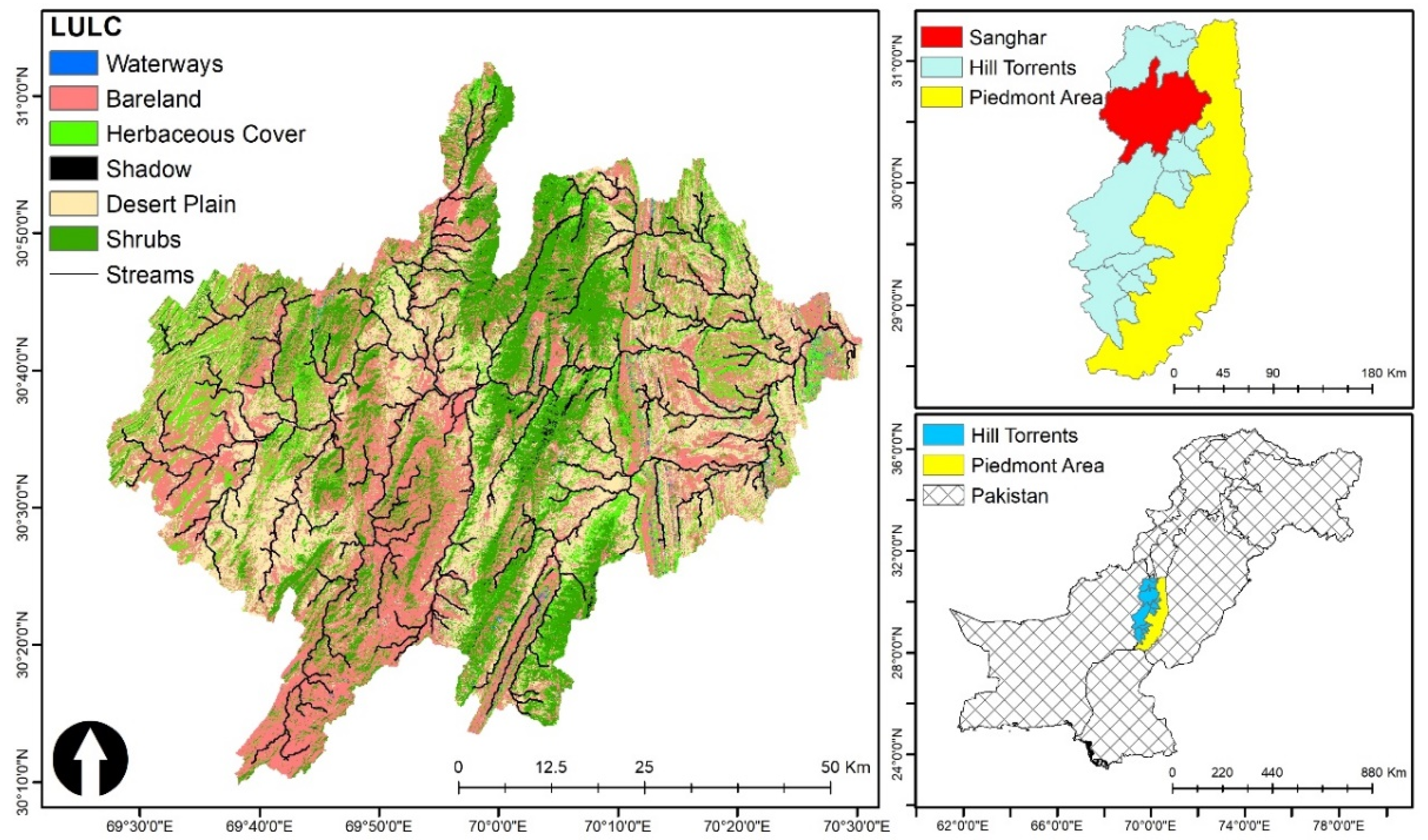
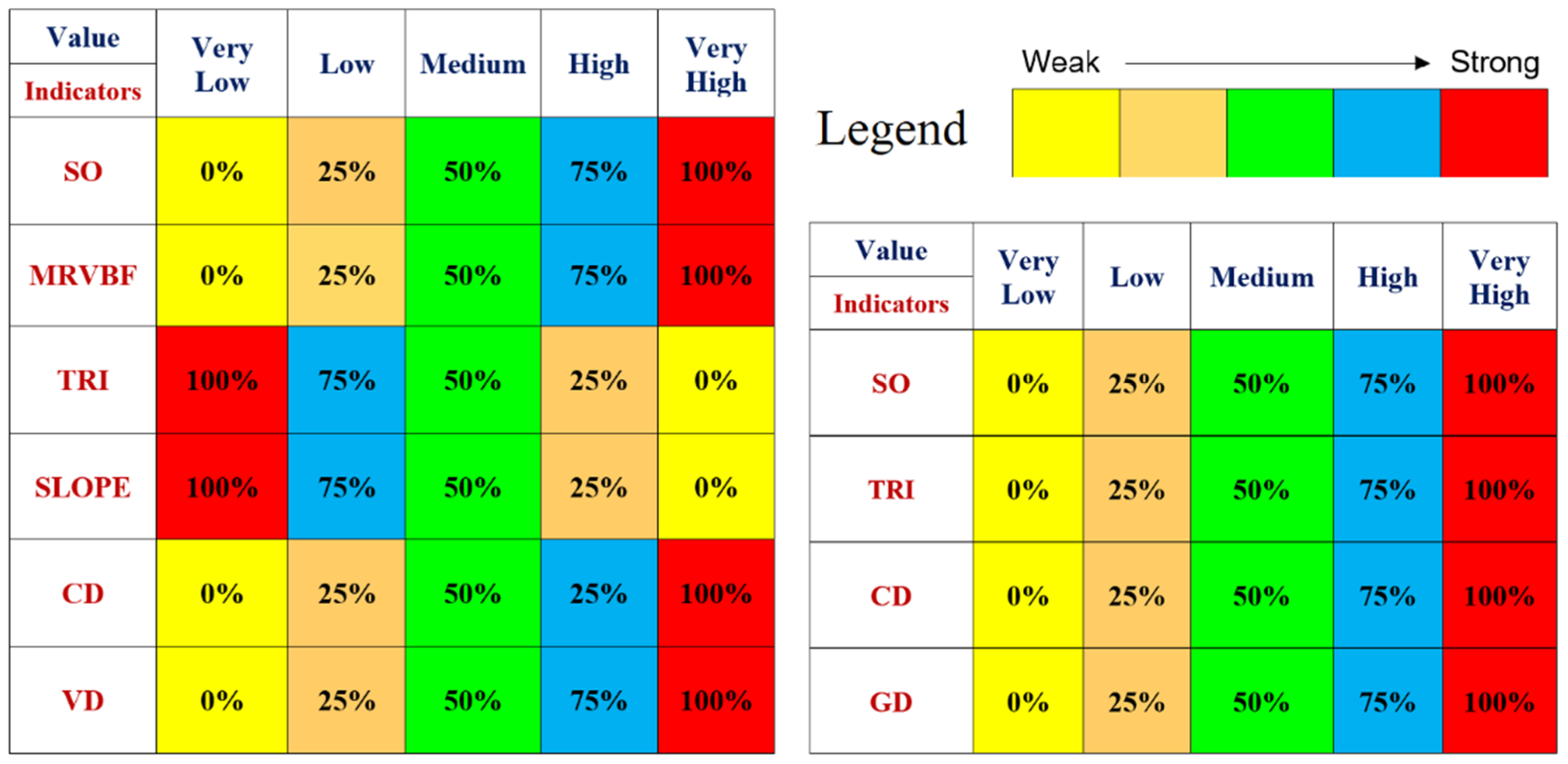
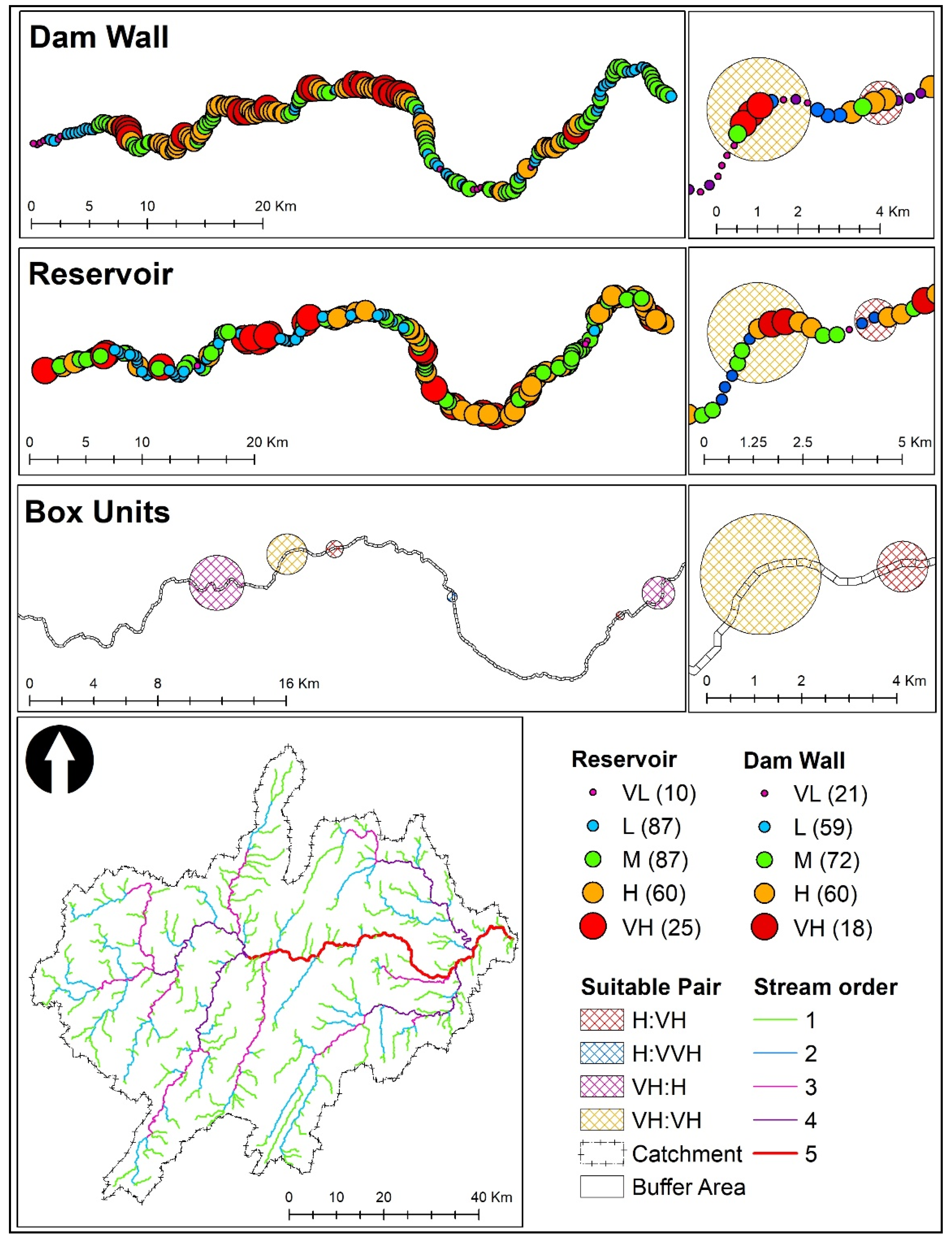
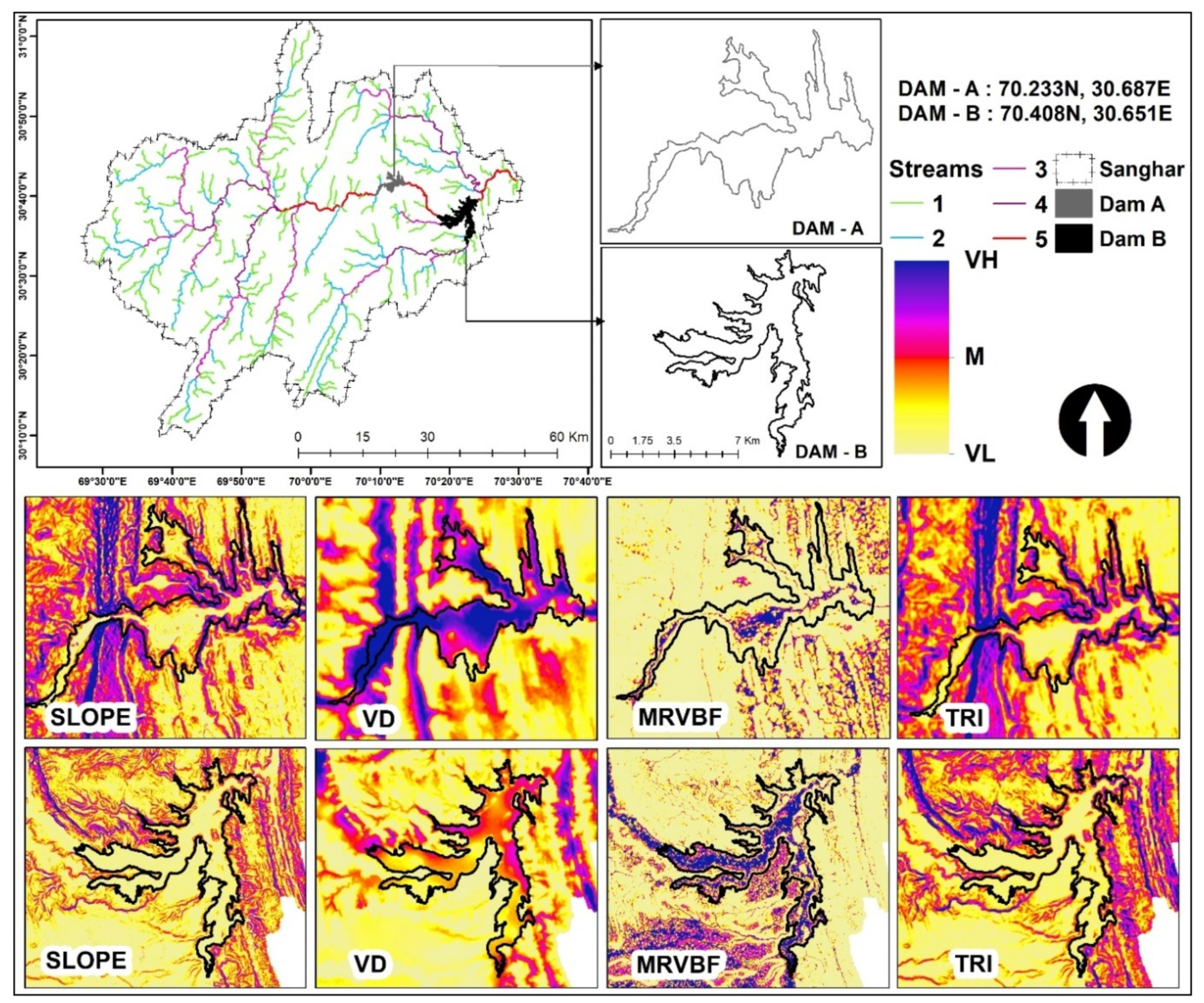

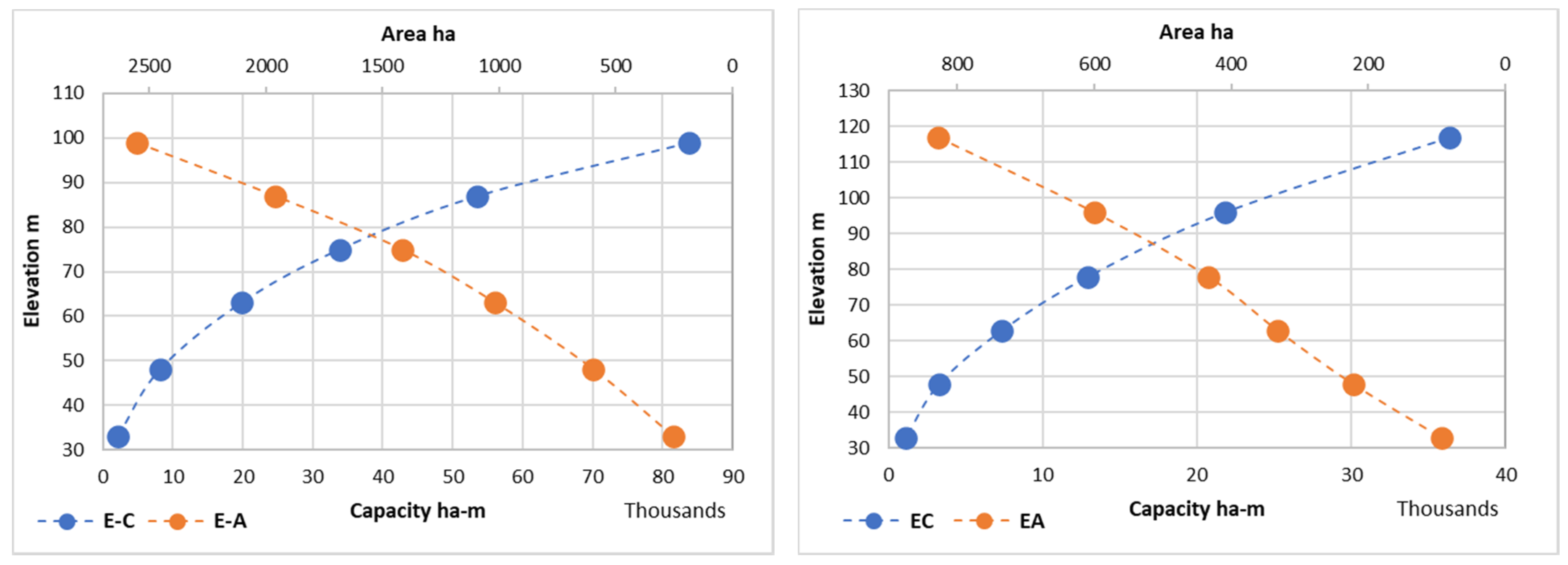
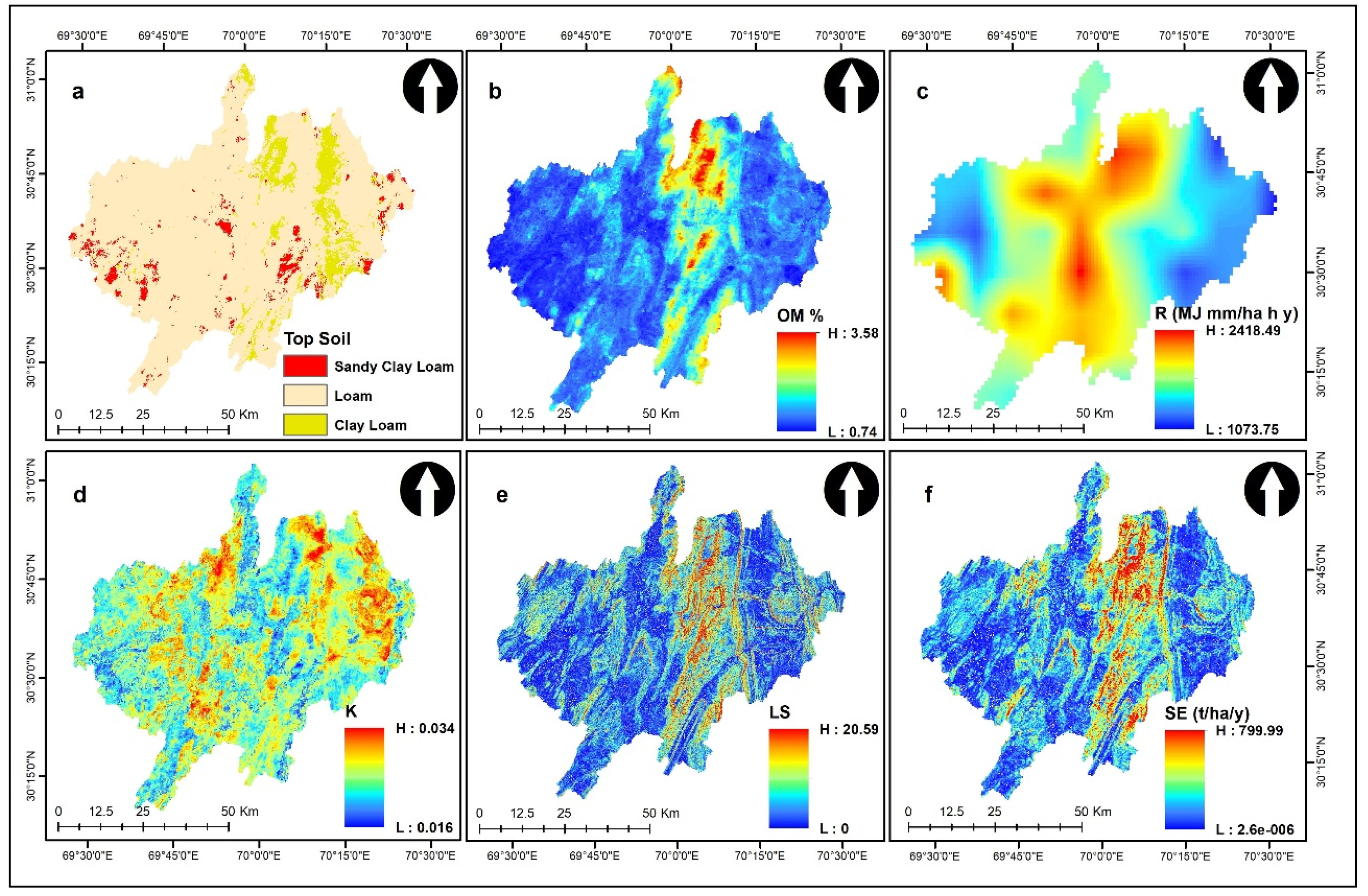
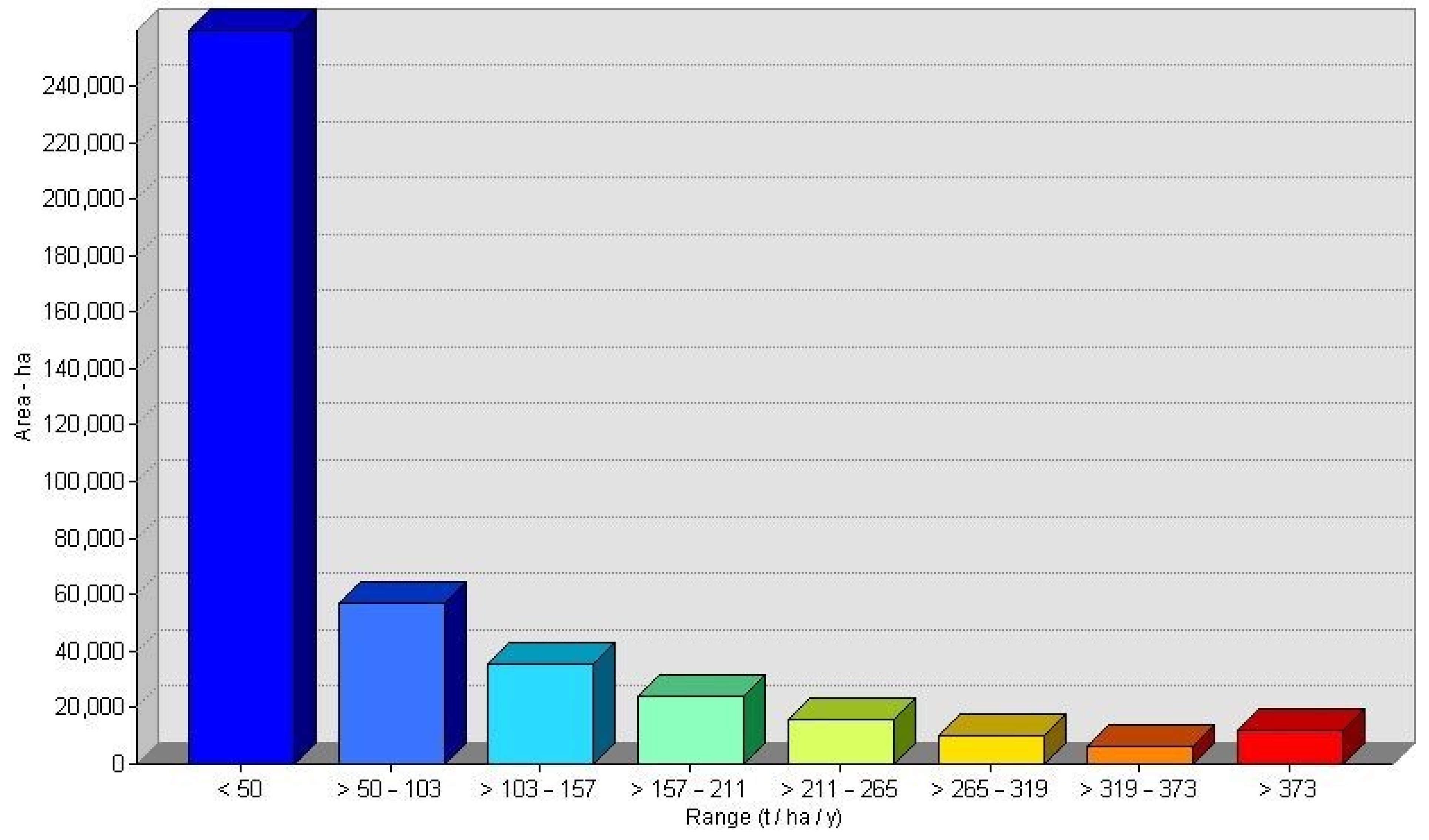
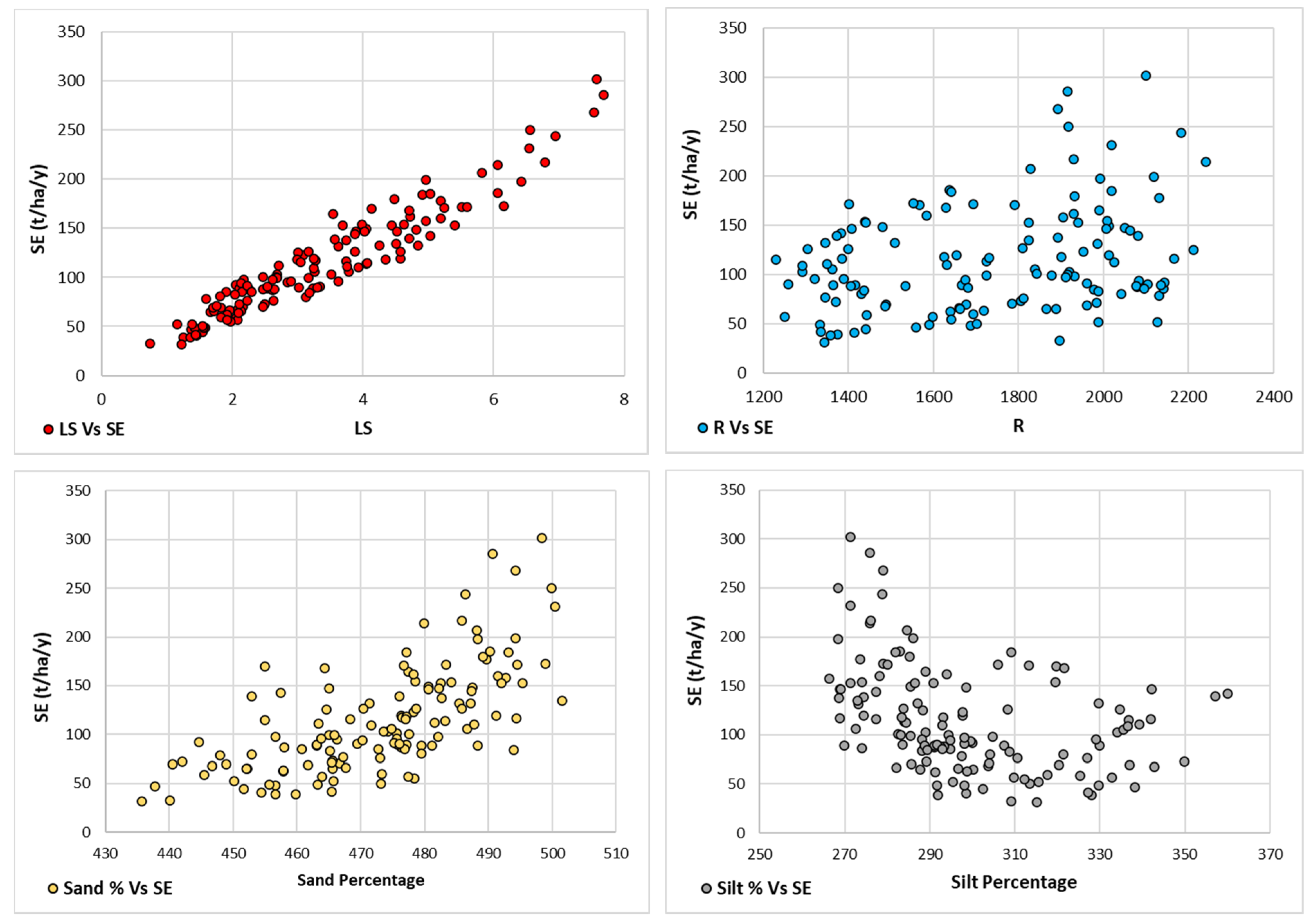
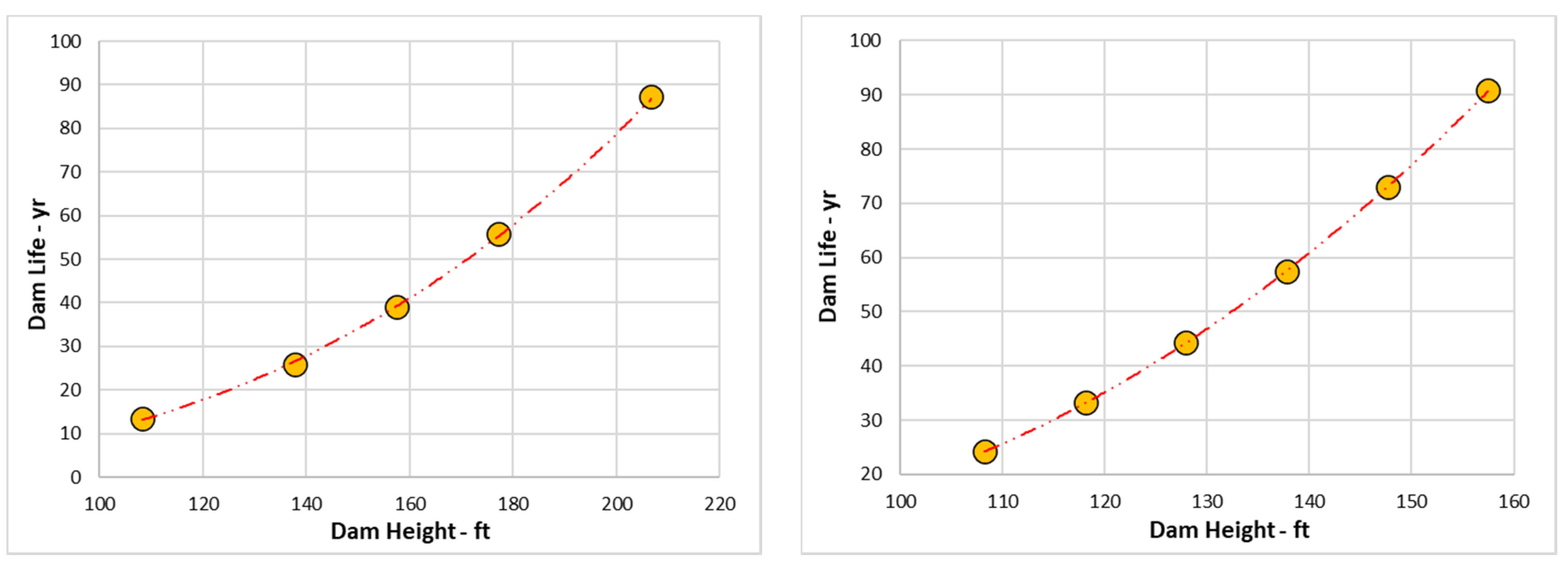
| Months | Avg. Discharge Cusecs | Min. Discharge Cusecs | Peak Discharge Cusecs | Total Events |
|---|---|---|---|---|
| March | 15,482 | 3675 | 35,081 | 11 |
| April | 20,598 | 3675 | 38,045 | 13 |
| May | 23,046 | 10,394 | 60,901 | 18 |
| June | 22,817 | 3675 | 64,449 | 39 |
| July | 31,829 | 6751 | 146,300 | 94 |
| August | 29,984 | 3675 | 83,156 | 64 |
| September | 14,360 | 6751 | 24,064 | 9 |
| Source Data | By-Products | Suitability/Analysis | Examination | Resolution/Source |
|---|---|---|---|---|
| Discharge | Daily discharge | Event Frequency | Quantitative | Daily/Irrigation Department |
| DEM | Stream | Reservoir | Qualitative | 5 m/Irrigation Department |
| Dam Wall | ||||
| MRVBF | Reservoir | |||
| TRI | Reservoir | |||
| Dam wall | ||||
| Slope | Reservoir | |||
| Dam wall | ||||
| CD | Reservoir | |||
| VD | Reservoir | |||
| GD | Dam wall | |||
| Contour | Dam wall | Qualitative-Quantitative | ||
| Reservoir | ||||
| LS | SE | |||
| GPM | R-factor | Quantitative | Daily-0.25°/Giovanni | |
| Soil | Percentage Sand | Qualitative-Quantitative | 250 m/soilgrid | |
| Percentage Silt | ||||
| Percentage Clay | ||||
| Percentage OM | ||||
| Satellite Imagery (Landsat-8) | CP-factor | 30 m/USGS-Glovis |
| Rules-Content is in % | Status | ||
|---|---|---|---|
| OM > 20% | - | Organic | - |
| OM ≤ 20% | Clay > 60 | Very Fine | 1 |
| Clay ≤ 60 & > 35 | Fine | 2 | |
| Clay ≤ 35 and Sand < 15 | Medium Fine | 3 | |
| Clay ≥ 18 & ≤ 35 and Sand ≥ 15 & ≤ 65 | Medium | 3 | |
| Clay < 18 and Sand > 65 | Coarse | 4 |
| Sr. No | Land Cover | C-Factor |
|---|---|---|
| 1 | Bare land | 1 |
| 2 | Desert Plain | 0.97 |
| 3 | Herbaceous Cover | 0.7 |
| 4 | Shrubs | 0.6 |
| 5 | Waterways | 0.98 |
| Indicators | Mean | Standard Deviation | Minimum | Maximum | Distribution |
|---|---|---|---|---|---|
| Slope (degree) | 12.25 | 9.82 | 0 | 81.19 | Skewed |
| TRI | 7.22 | 5.84 | 0 | 125.09 | Skewed |
| MrVBFI | 0.267 | 0.552 | 0 | 4.98 | Skewed |
| CDI | 1.24 | 1.53 | 9 × 10−4 | 79.03 | Skewed |
| VD (m) | 39.55 | 35.034 | 0 | 364.19 | Skewed |
| GDI | 0.266 | 0.142 | 0.056 | 1.44 | Skewed |
| Dam | Max. Height m | Top Width m | Reservoir Area at Max. Height-ha | Catchment Area Mha | Capacity Mm3 | Elevation of Base Contour m | Cross Slope Degree | Stream Order |
|---|---|---|---|---|---|---|---|---|
| A | 117 | 445 | 828 | 0.299 | 363.92 | 513 | 45–55 | 5th |
| B | 99 | 436 | 2554 | 0.405 | 838.42 | 291 | 42–50 | 5th |
Publisher’s Note: MDPI stays neutral with regard to jurisdictional claims in published maps and institutional affiliations. |
© 2021 by the authors. Licensee MDPI, Basel, Switzerland. This article is an open access article distributed under the terms and conditions of the Creative Commons Attribution (CC BY) license (http://creativecommons.org/licenses/by/4.0/).
Share and Cite
Munir, B.A.; Ahmad, S.R.; Rehan, R. Torrential Flood Water Management: Rainwater Harvesting through Relation Based Dam Suitability Analysis and Quantification of Erosion Potential. ISPRS Int. J. Geo-Inf. 2021, 10, 27. https://doi.org/10.3390/ijgi10010027
Munir BA, Ahmad SR, Rehan R. Torrential Flood Water Management: Rainwater Harvesting through Relation Based Dam Suitability Analysis and Quantification of Erosion Potential. ISPRS International Journal of Geo-Information. 2021; 10(1):27. https://doi.org/10.3390/ijgi10010027
Chicago/Turabian StyleMunir, Bilal Ahmad, Sajid Rashid Ahmad, and Raja Rehan. 2021. "Torrential Flood Water Management: Rainwater Harvesting through Relation Based Dam Suitability Analysis and Quantification of Erosion Potential" ISPRS International Journal of Geo-Information 10, no. 1: 27. https://doi.org/10.3390/ijgi10010027
APA StyleMunir, B. A., Ahmad, S. R., & Rehan, R. (2021). Torrential Flood Water Management: Rainwater Harvesting through Relation Based Dam Suitability Analysis and Quantification of Erosion Potential. ISPRS International Journal of Geo-Information, 10(1), 27. https://doi.org/10.3390/ijgi10010027




